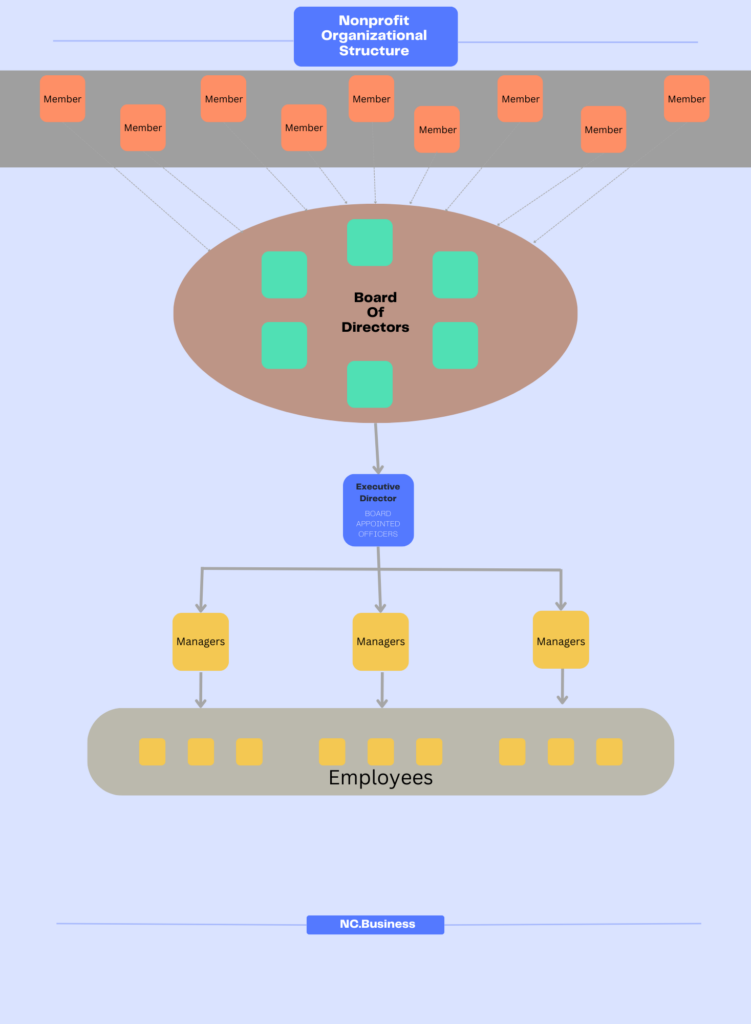The Nonprofit Corporation structure is a top down flowchart of authority. It all starts with the members or board and flows through the organization.

Members
Not all nonprofits have members. Even if your nonprofit has members, they may not be legal members under North Carolina law. In order to be a member organization, you have to have checked the box in your articles that says “This Corporation has Members”. Unless you have a specific reason to do so, I recommend not having members.
Members, under North Carolina law, are the highest tier of authority in a nonprofit. They have the right to appoint a board of directors, change any governing documents, make major decisions regarding the organization, and they have specific rights in regard to access to the organization and it’s records. In my opinion, it’s easier to avoid this altogether.
Typically, member organizations are HOAs, labor unions, industry-specific professional groups, credit unions, and similar types of organizations. Even if you have “members,” you can treat them as stakeholders without giving them all the member power.
So, if you have Members, these people have to get together regularly (at least once per year) to appoint board members, approve budgets, etc. You have to ensure you have a quorum when they meet which means you either need 50% of your total membership base or the number specified in your bylaws.
Law++ has actually encounter the problem with having members multiple times. Ultimately we’ve been able to make the necessary changes to get things how they should, but it was extremely time-consuming, expensive, and stressful.
Board of Directors
If you have members, the Board of Directors is the next tier of a nonprofit’s organizational structure. If you don’t have members, the Board of Directors is the highest tier in your nonprofit. The individual directors are elected either by the Board of Directors itself (without members) or by the members (with members). Terms can be set by the bylaws. Without specific instructions in your bylaws, every director serves a one-year term.
I recommend setting director terms to two or three years and have them staggered. For example, on a nine person board, I like to make 3 board positions come up for reelection every year. With 3 year terms, there’s always six members who have served at least 1 year unless there were unplanned vacancies. This keeps your institutional knowledge alive and well.
Your board of directors serves as a committee that makes high level decisions. They typically make/approve the budget, steer the direction of the organization, and elect the top level officers, like the Executive Director, of the organization.
Executive Director
Your executive director, or other board-appointed officers, are legally the officers of the corporation. These officers run the day-to-day, hire employees, and report directly to the board of directors. You can call this position whatever you want. However, the IRS and state agencies understand terms like “Executive Director,” “President,” and “CEO”. However, I wouldn’t recommend using “CEO” for a nonprofit organization just to avoid the confusion of people thinking it is a for-profit organization.
Managers
Next, you have managers hired by the executive director. Managers in a nonprofit would act exactly as managers would act in a for-profit company. They’re giving a job description, goals, and direction from upper management. They report to the executive director or whatever supervisor they have, and they manage employees underneath them.
Employees
Employees are employees. Employees, in a nonprofit, are the lowest tier of authority. They can and should do what their managers and supervisors instruct them to do.
Nonprofit Corporation Structure
That’s the nonprofit corporation structure. It starts at the top and each tier can delegate some or all of its power to the tier below them. No tiers can delegate more power than they have. For example, the Executive Director cannot have a manager approve the budget for the organization because that power belongs to the board of directors.
Modifications for Small Nonprofits
If you’re reading this and thinking “there’s no way I can get enough people to fill this chart,” you’re not alone. Smaller nonprofits skip some of these positions and have people filling multiple roles. For example, most small nonprofits have the board doing a lot of the work employees would do. This is called a “working board” and is perfectly legitimate. The important part to remember is that if a person holds multiple positions, they can only act in one at a time.
Take this example: Let’s say Neil is on the board of directors, serves as executive director, and is a member. When acting as a board member, he cannot act as executive director or member. Therefore, he has to do what’s in the best interest for the organization as a whole in his director role because this is their duty. When he switches to member, he can act in his own best interest.
Furthermore, I recommend keeping the executive director off the board of directors. Holding both these positions creates a ton of conflicts of interest that you’d have to tiptoe to avoid.
There you have it! That’s the nonprofit corporation structure.